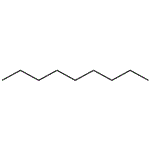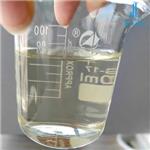- N-NONANE
-

- $1.50 / 1g
-
2023-07-27
- CAS:111-84-2
- Min. Order: 1g
- Purity: 99.0% Min
- Supply Ability: 100 Tons
- N-NONANE
-

- $1.00 / 1kg
-
2023-03-21
- CAS:111-84-2
- Min. Order: 1kg
- Purity: 99.8%
- Supply Ability: 20tons
- N-NONANE
-

- $1.00 / 1PCS
-
2021-02-05
- CAS:111-84-2
- Min. Order: 1PCS
- Purity: 99%
- Supply Ability: 10 mt
|
| | N-NONANE Basic information |
| | N-NONANE Chemical Properties |
| Melting point | -53 °C | | Boiling point | 151 °C(lit.) | | density | 0.72 g/mL at 20 °C | | vapor density | 4.41 (vs air) | | vapor pressure | 0.18 psi ( 37.7 °C) | | refractive index | n20/D 1.407 | | Fp | 88 °F | | storage temp. | Store below +30°C. | | solubility | In methanol, g/L: 84 at 5 °C, 95 at 10 °C, 105 at 15 °C, 116 at 20 °C, 129 at 25 °C, 142 at 30 °C,
155 at 35 °C, 170 at 40 °C (Kiser et al., 1961). Miscible with many aliphatic hydrocarbons. | | pka | >14 (Schwarzenbach et al., 1993) | | form | Liquid | | Specific Gravity | 0.72 (20/4℃) | | color | Clear colorless | | Odor | gasoline | | Odor Threshold | 2.2ppm | | explosive limit | 0.7-5.6%(V) | | Water Solubility | Miscible with ethanol, ether, acetone, benzene, chloroform and hydrogen peroxide. Immiscible with water. | | BRN | 1696917 | | Henry's Law Constant | 2.32 at 25 °C (J?nsson et al., 1982) | | Exposure limits | NIOSH REL: TWA 200 ppm (1,050 mg/m3); ACGIH TLV: TWA 200 ppm
(adopted). | | Dielectric constant | 2.0(20℃) | | Stability: | Stable. Highly flammable. Incompatible with strong oxidizing agents. | | LogP | 5.293 (est) | | CAS DataBase Reference | 111-84-2(CAS DataBase Reference) | | EPA Substance Registry System | Nonane (111-84-2) |
| | N-NONANE Usage And Synthesis |
| Chemical Properties | Nonane is a colorless liquid. | | Chemical Properties | colourless liquid | | Chemical Properties | n-Nonane, C9H20, is a colorless, highly flammable liquid.
Nonane is a constituent in the paraffin
fraction of crude oil and natural gas. It is released to the
environment via the manufacture, use, and disposal of
many products associated with the petroleum and gasoline
industries. | | Physical properties | Clear, colorless, flammable liquid with a gasoline-like odor. An odor threshold concentration of
2.2 ppmv was reported by Nagata and Takeuchi (1990). | | Uses | Solvent; organic synthesis; distillation
chaser; major ingredient of such petroleum
fractions as VM&P naphtha, 140 flash, Stoddard
solvent, and gasoline | | Uses | Nonane is used in organic synthesis, as a solvent, as a distillation chaser and as a fuel additive. It is also used in biodegradable detergent. It is an active ingredient of such petroleum fractions as varnish makers and painter naphtha, 140 flash, stoddard solvents and in gasoline. | | Uses | Organic synthesis, biodegradable detergents,
distillation chaser. | | Definition | ChEBI: A straight chain alkane composed of 9 carbon atoms. | | Synthesis Reference(s) | Journal of the American Chemical Society, 95, p. 6452, 1973 DOI: 10.1021/ja00800a052
The Journal of Organic Chemistry, 44, p. 2705, 1979 DOI: 10.1021/jo01329a023
Tetrahedron Letters, 32, p. 1691, 1991 DOI: 10.1016/S0040-4039(00)74305-X | | General Description | A clear colorless liquid with a sharp odor. Flash point 86°F. Insoluble in water and less dense than water. Contact may irritate eyes and possibly injury the cornea. May irritate skin. Vapor inhalation may cause irritation. Prolonged inhalation may lead to breathing difficulty. Ingestion causes abdominal discomfort, nausea and diarrhea. | | Air & Water Reactions | Highly flammable. Insoluble in water. | | Reactivity Profile | NONANE is incompatible with oxidizing materials. N-NONANE is also incompatible with oxygen. . | | Hazard | Flammable, moderate fire risk. Irritant, narcotic in high concentration. Central nervous system
impairment. | | Health Hazard | Inhalation of concentrated vapor causes depression, irritation of respiratory tract, and pulmonary edema. Liquid can irritate eyes and (on prolonged contact) skin. Ingestion causes irritation of mouth and stomach. Aspiration causes severe lung irritation, rapidly developing pulmonary edema, and central nervous system excitement followed by depression. | | Safety Profile | Poison by intravenous
route. Mildly toxic by inhalation. Irritating to
respiratory tract. Narcotic in high
concentrations. A very dangerous fire
hazard when exposed to heat or flame; can
react with oxidizing materials. Explosive in
the form of vapor when exposed to heat or
flame. Emitted from modern building
materials (CENEAR 69,22,91). To fight fire,
use CO2, dry chemical. When heated to
decomposition it emits acrid smoke and
irritating fumes. | | Potential Exposure | Nonane is used in the synthesis of biodegradable
detergents as a distillation chaser; an ingredient
in Stoddard solvent and gasoline. | | Source | Schauer et al. (1999) reported nonane in a diesel-powered medium-duty truck exhaust at
an emission rate of 160 μg/km.
Identified as one of 140 volatile constituents in used soybean oils collected from a processing
plant that fried various beef, chicken, and veal products (Takeoka et al., 1996).
Schauer et al. (2001) measured organic compound emission rates for volatile organic
compounds, gas-phase semi-volatile organic compounds, and particle-phase organic compounds
from the residential (fireplace) combustion of pine, oak, and eucalyptus. The gas-phase emission
rate of nonane was 3.9 mg/kg of pine burned. Emission rates of nonane were not measured during
the combustion of oak and eucalyptus.
California Phase II reformulated gasoline contained nonane at a concentration of 2.08 g/kg.
Gas-phase tailpipe emission rates from gasoline-powered automobiles with and without catalytic
converters were 0.43 and 45.3 mg/km, respectively (Schauer et al., 2002). | | Environmental fate | Biological. Nonane may biodegrade in two ways. This first is the formation of nonyl hydroperoxide,
which decomposes to 1-nonanol followed by oxidation to nonanoic acid. The other
pathway involves dehydrogenation to 1-nonene, which may react with water giving 1-nonanol
(Dugan, 1972). Microorganisms can oxidize alkanes under aerobic conditions. The most common
degradative pathway involves the oxidation of the terminal methyl group forming 1-nonanol. The
alcohol may undergo a series of dehydrogenation steps forming nonanal then a fatty acid
(nonanoic acid). The fatty acid may then be metabolized by β-oxidation to form the mineralization
products, carbon dioxide, and water (Singer and Finnerty, 1984).
Photolytic. Atkinson reported a photooxidation rate constant of 1.02 x 10-11 cm3/molecule?sec
for the reaction of nonane and OH radicals in the atmosphere. Photooxidation reaction rate
constants of 1.0 x 10-11 and 2.30 x 10-16 cm3/molecule?sec were reported for the reaction of nonane
with OH and NO3, respectively (Sablji? and Güsten, 1990).
Chemical/Physical. Complete combustion in air yields carbon dioxide and water. | | Shipping | UN1920 Nonanes, Hazard Class: 3; Labels:
3-Flammable liquid. | | Purification Methods | Fractionally distil n-nonane, then stir it with successive volumes of conc H2SO4 for 12hours each until no further coloration is observed in the acid layer. Then wash it with water, dry with MgSO4 and fractionally distil it. Alternatively, it is purified by azeotropic distillation with 2-ethoxyethanol, followed by washing out the alcohol with water, drying and distilling it. [Forziati et al. J Res Nat Bur Stand 36 129 1946, Beilstein 1 IV 447.] | | Incompatibilities | Nonane forms explosive mixture with
air. Incompatible with oxidizers (chlorates, nitrates, peroxides,
permanganates, perchlorates, chlorine, bromine, fluorine,
etc.); contact may cause fires or explosions. Keep
away from alkaline materials, strong bases, strong acids,
oxoacids, epoxides. | | Waste Disposal | Dissolve or mix the material
with a combustible solvent and burn in a chemical
incinerator equipped with an afterburner and scrubber.
All federal, state, and local environmental regulations
must be observed. |
| | N-NONANE Preparation Products And Raw materials |
|